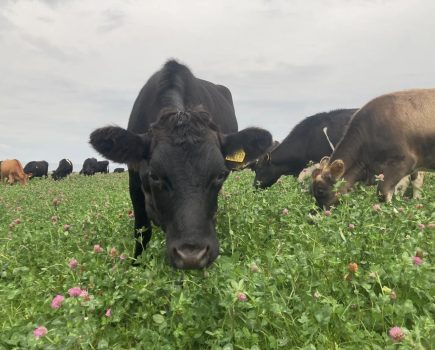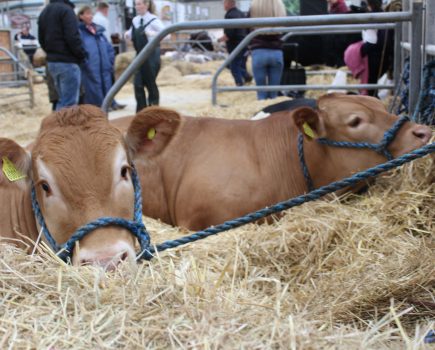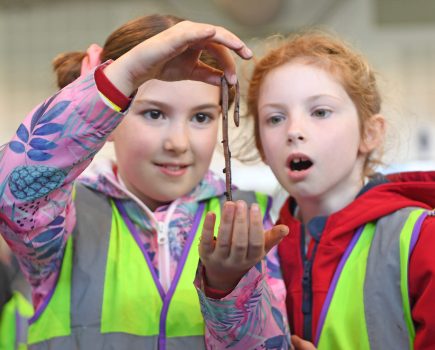Carol Harris discusses rearing piglets
In this article we’ll deal with looking after growing piglets. Most mums I know say that teenagers (the human kind) are at the hardest age to deal with. I think the same applies to piglets. They’re cute and fun when tiny, and develop individual characters as adults. But teenage piglets are boisterous, noisy, loutish and behave like a gang. So, although we’re talking about rearing piglets, you should be prepared for them to change from adorable babies into delinquents within a few short weeks. Let’s start from their earliest days. When the newborn piglets are feeding well, the mother will do most of what’s needed to look after them for their first week or so. You should, however, make sure they’re all continuing to feed properly. Any piglets that aren’t feeding well are likely to either be constantly squeaking, or else listless and lethargic. If all the others are feeding well, it may be that you have a piglet with an ailment or, less likely, a teat that isn’t producing milk. Piglets become ‘attached’ to their own teat very quickly and often defend their food source from their litter mates. If you have a large litter, one or more piglets can fail to get sufficient food, either because there isn’t a spare teat for them, or because the teat they’ve latched onto isn’t producing sufficient milk. In some instances, the mother may have developed mastitis, where infection causes the udders to become very hard. This can lead to lack of milk and sometimes to the udder becoming permanently unproductive. It can also make the sow very irritable because it can be very painful – in this case, she may be unwilling to feed her piglets, or keep moving about, adding to the possibility of them being trampled or flattened. And, of course, if your sow completely fails to produce milk, you will need to hand-rear or foster the piglets . If a piglet isn’t getting enough nutrition, you can supplement by bottle feeding if necessary or, if you have two sows with litters, you may be able to foster a piglet onto another sow. If, however, the milk supply isn’t the problem, you may need to call in your vet to check out the piglet’s health. And if there are several piglets that aren’t thriving, there’s a possibility of a general infection, in which case it needs to be dealt with before the whole litter succumbs to it. Home comforts As well as feeding well, the piglets need warmth. Young piglets do best in temperatures of around 21-24ºC (70-75ºF) and my own preference is to provide an infra-red lamp in a creep area of the farrowing shed. As well as keeping the piglets warm, it allows them a place where they can sleep away from their mother, which is enormously helpful in stopping her from squashing them. You should also make sure that the general area is draught-free and that there’s plenty of bedding on the ground, especially if the floor is concrete rather than wood. Also, make sure that any water supply they can get close to is shallow enough that they don’t drown in it. If you have an automatic drinker that’s quite deep, a couple of bricks placed in it will allow any inquisitive piglets to clamber out if they fall in. I always keep the doors of the farrowing shed closed for a week or 10 days, depending on the weather, and let the mother out at regular intervals to feed and relieve herself. After that, I keep the doors closed at night until the piglets are about three weeks old (again, depending on the weather). I recently had one mother that insisted on lying outside in the snow if I left the doors open and her litter then had to lie on cold concrete to feed – not at all sensible. In that case, I kept them shut in until the weather had improved. Closing the doors protects against both cold and predators such as foxes. Well fed Be careful to ensure that the piglets get the minerals they need. They can become iron deficient if kept indoors for too long, and benefit from being able to nibble at, and dig, soil. If you can’t let them run in a field, then you can always put a few turves in with them to give them the opportunity to eat some of the earth. I’ve never given my piglets iron injections, which some people recommend, and they’ve always thrived. If you do want to give iron in this way, you need to be careful that it’s given at the right time, as it can be very dangerous to give outside a particular period of time – check with your own vet if you want to do this. You can start weaning your piglets at about three weeks, although some people put milk pellets in the creep area from 10 days or so to get them used to solid food. At around three weeks, the piglets can be given special pellets that are smaller than the adult food and higher in protein. They will eat very little at the beginning, but the amount can gradually be increased as they get used to the food. The piglets are also likely to nibble on their mother’s food pellets as well, but will tend to prefer the smaller ones which are easier for them to chew. Be careful that any food you put down for the piglets is out of the reach of their mum (feed her outside and them inside if in any doubt). If the sow gets too much piglet food with the higher protein level, she’s likely to scour. And don’t leave baby food down for too long – if it hasn’t been eaten within half an hour, remove it. Young piglets will also explore avidly and put anything into their mouths that they possibly can. Be careful, therefore, not to leave lengths of twine, broken glass, mouse poison, sharp blades or any other hazardous materials anywhere near them. And also remember that sows too can be inclined to explore, so if you have shelving in your farrowing shed, avoid putting anything on it that the sows can pull down onto their piglets. I store straw on shelves above the farrowing areas, but make sure it’s pushed well back so the sows can’t pull the bales down. Once the piglets are happily eating small pellets, they’re well on the way to being weaned. At around eight weeks of age, they can be removed from their mothers, although if you prefer, you can leave them until 10 or 12 weeks, as long as the litter isn’t too large and too draining on the mother, making her lose weight and condition. Also, larger piglets are likely to be very heavy when feeding together and the mother is unlikely to appreciate them much after eight weeks or so. When you decide to remove the piglets, the mother should be walked away from them and they should be left in the house they’ve been occupying since birth. This is much less stressful for the piglets than removing them from the mother and putting them in a strange place. The sow’s udders should dry up naturally, although if she has lots of milk, she might be uncomfortable for a few days because of the pressure it causes. If the udders are very enlarged for more than a few days, or get very hard, you might want to check with your vet in case there’s a problem, but on the whole, the drying-up process seems to present little problem to the sows. Once weaned, the piglets should be given about 1lb of solid food per month of age, so a two-month piglet would have 2lbs of food a day, and at four months or more, 4lbs a day. On the whole, 4lbs a day should then be sufficient until the piglets go for slaughter. If they’re kept for breeding, 4lbs a day should be sufficient for an average sized pig, with really large pigs, or working boars, getting a higher ration. It’s good to supplement the dry food with grass and fresh fruit and vegetables so that the piglets get a mixed diet. Be careful not to add too much fodder beet as this can make them quite fat – although they love the sweet taste and, in moderation, it does them good. Separate If you have space, it’s good to separate the male and female piglets and this can be done either at weaning or at a later stage. The purpose of this is to prevent the males having the opportunity to mate with the females if they become sexually active at a very early age. With pigs going for meat, this may not be a problem, as they aren’t likely to be kept long enough to be that mature, but with bacon pigs – or ‘early developers’, it could be an issue. There is also the possibility that male pigs that have mated a female could produce certain hormones in their bodies that can give their meat an ‘off’ flavour – called ‘boar taint’ – although if they go to slaughter at a relatively early age, this is unlikely to be a problem. Some people, on the other hand, dispute the fact that boar taint exists, so it’s a slightly controversial issue. Be prepared for your growing piglets to be vocal, pushy, good escape artists and excellent at digging. Never underestimate the time they will take up, the volume of food they will require and the additional work involved in cleaning their houses and runs. As long as you take all this into account, raising piglets can be a very rewarding activity, and provide hours of entertainment as well as eventual food and income. nThis article is from the August 2006 issue of Country Smallholding magazine. << To order back issues click the link to the left.







